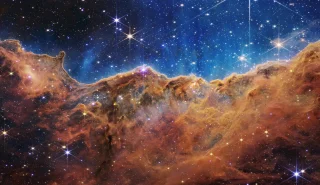These first images from the world’s largest and most powerful space telescope demonstrate Webb at its full power, ready to begin its mission to unfold the infrared universe.
Unglaubliche Bilder.
Das Weblog von Stefan Grund, der im Netz als @eay unterwegs ist und hier seit 2003 über Medien, Popkultur und Technologie schreibt. Mehr »
These first images from the world’s largest and most powerful space telescope demonstrate Webb at its full power, ready to begin its mission to unfold the infrared universe.
Unglaubliche Bilder.

Webb's most recent images released by NASA in 2025, displayed in reverse chronological order.
Es gibt ein „NASA e-Book Archive“ mit ein paar Dutzend Veröffentlichungen jeweils kostenlos als EPUB, Mobi und PDFs. (via Eli)
NASA’s Curiosity rover captured its highest-resolution panorama yet of the Martian surface between Nov. 24 and Dec. 1, 2019. A version without the rover contains nearly 1.8 billion pixels; a version with the rover contains nearly 650 million pixels. Both versions are composed of more than 1,000 images that were carefully assembled over the following months.

Passend zu der Analyse des Scissor-Emoji von neulich, hier zwei Twitter-Threads mit weiteren Emoji-Analysen:
Wichtige, wissenswerte Arbeit!

So sieht übrigens die Oberfläche der Sonne aus, erstmals so aufgenommen vom Daniel K. Inouye Solar Telescope. Jede der „Zellen“ ist dabei so groß wie Texas. Das Video zeigt einen Zeitraffer von 10 Minuten Sonnenaktivität. Hier gibt es weitere Bilder und Erklärungen. (via Kottke)
„Bringing back the weird web!“ hat sich Neal Agarwal auf seiner und für seine Webseite vorgenommen und das gelingt ihm mit einem guten Dutzend kleiner Web-Experimente auch tatsächlich sehr gut und oftmals sehr informativ. So auch „The Size of Space“, das ausgehend von einem Astronauten die Größenverhältnisse im Weltall aufzeigt. (via Waxy)
The Oatmeal erklärt die NASA-Mission InSight, die kommenden Montag (Cyber Monday!) auf dem Mars landet.
Astronauts on the International Space Station need to relax, just like the rest of us. So it’s no surprise that there are movies and TV shows on board for them to watch. I’ve obtained the complete list through a Freedom of Information request.
Spacehack.org is a directory of ways to participate in space exploration. We curate awesome projects that allow for anyone, with or without a formal science background, to make an active contribution to the furthering of space exploration and knowledge.
Stuff in Space is a realtime 3D map of objects in Earth orbit, visualized using WebGL. The website updates daily with orbit data from Space-Track.org and uses the excellent satellite.js Javascript library to calculate satellite positions.